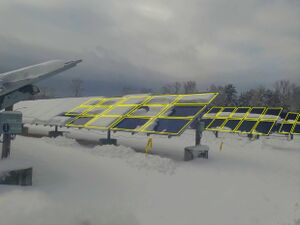
Modeling and predicting snow-related power loss is important to economic calculations, load management and system optimization for all scales of photovoltaic (PV) power plants. This paper describes a new method for measuring snow shedding from fielded modules and also describes the application of this method to a commercial scale PV power plant in Vermont with two subsystems, one with modules in portrait orientation and the other in landscape. The method relies on time-series images taken at 5 minute intervals to capture the dynamics of module-level snow accumulation and shedding. Module-level images extracted from the full-field view are binarized into snow and clear areas, allowing for the quantification of percentage snow coverage, estimation of resulting module power output, and temporal changes in snow coverage. Preliminary data from the Vermont case study suggests that framed modules in portrait orientation outperform their framed counterparts in landscape orientation by as much as 24% energy yield during a single shedding event. While these data reflect a single event, and do not capture snow shedding behavior across diverse temperature and other climatic conditions, the study nonetheless demonstrates that 1) module orientation and position in the array influence shedding patterns; 2) the start of power production and bypass diode activation differ for portrait and landscape module orientations at similar percentages and orientations of snow coverage; and 3) system design is an important factor in snow mitigation and increased system efficiency in snowy climates.
See also[edit | edit source]
- The Impact of Snow Losses on Solar Photovoltaic Systems in North America in the Future
- Snow Losses for Photovoltaic Systems: Validating the Marion and Townsend Models
- Monofacial vs bifacial solar photovoltaic systems in snowy environments
- A new method to determine the effects of hydrodynamic surface coatings on the snow shedding effectiveness of solar photovoltaic modules
- Impact of Snow and Ground Interference on Photovoltaic Electric System Performance
- Prediction of energy effects on photovoltaic systems due to snowfall events
- Open Solar Outdoors Test Field
- Outdoor data acquisition
- Queen's Innovation Park Test Site
- Solar resource measurement for PV applications
- Performance of Bifacial Photovoltaic Modules on a Dual-Axis Tracker in a High-Latitude, High-Albedo Environment
- Differences in Snow Shedding in Photovoltaic Systems with Framed and Frameless Modules
- A Review of the Effects of Haze on Solar Photovoltaic Performance
- ---
- OS Computer Vision for Distributed Recycling and Additive Manufacturing
- Other OS Computer Vision Applications












